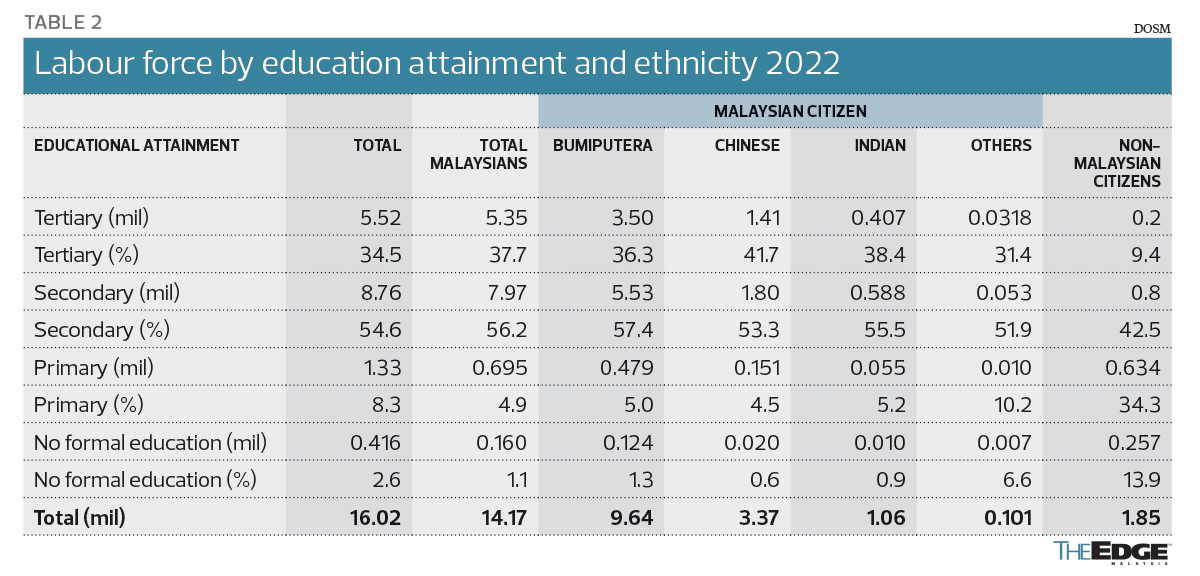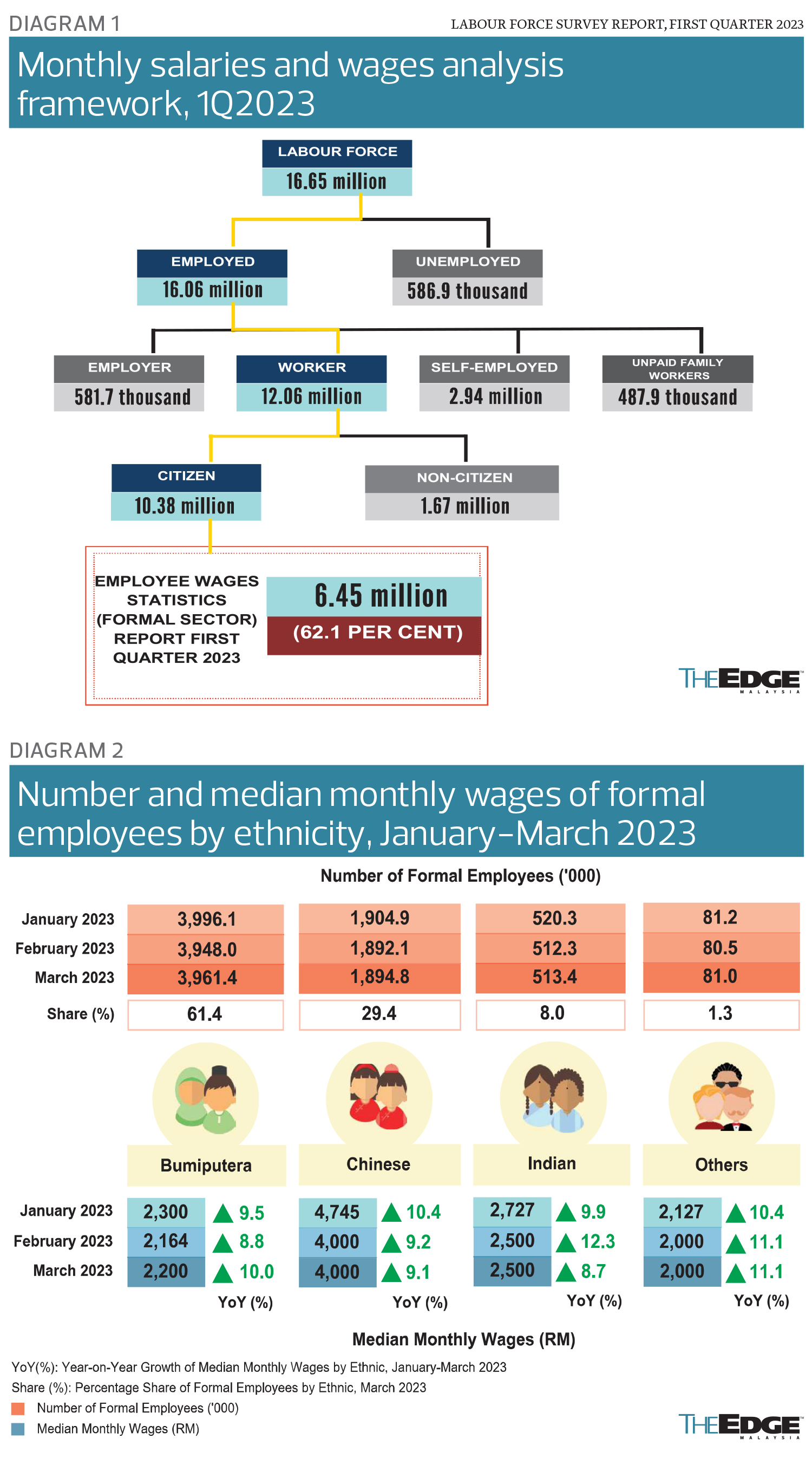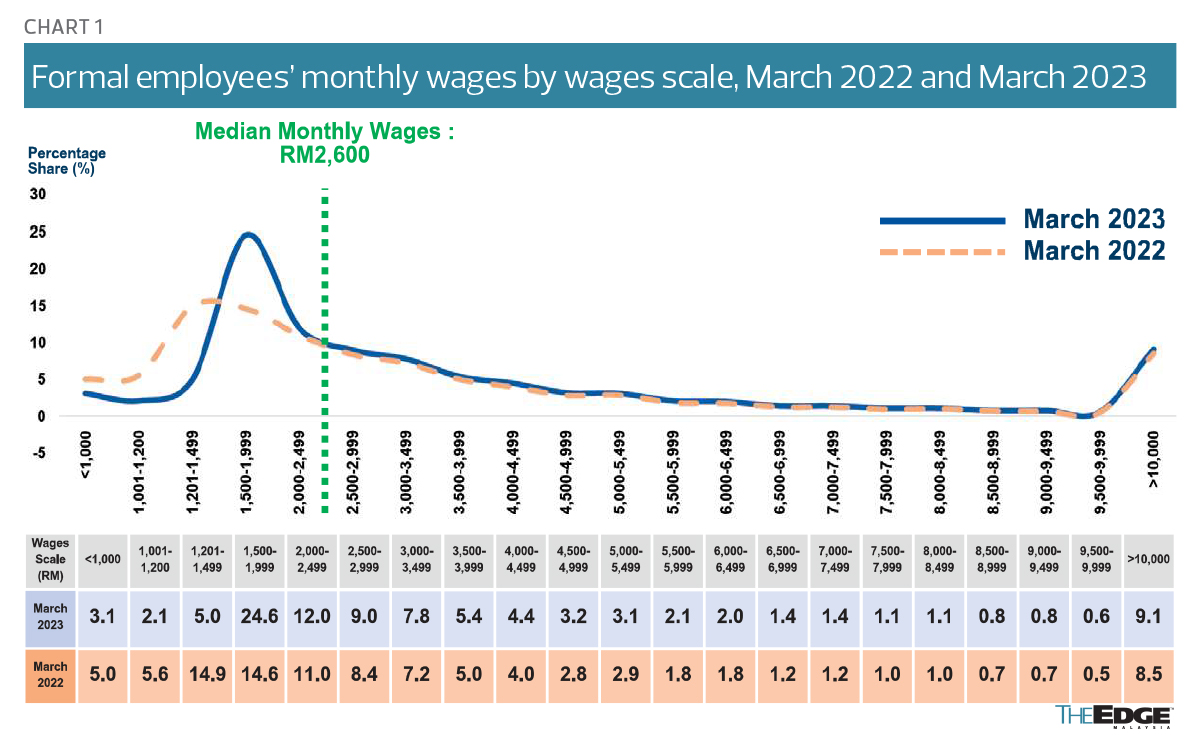
This article first appeared in The Edge Malaysia Weekly on September 11, 2023 - September 17, 2023
THE low level of retirement savings among Malay and other bumiputera private sector wage earners compared with their fellow Malaysians of Chinese and Indian ethnicity recently made headlines when lawmakers provided such numbers in parliament when arguing against more premature withdrawals of statutory retirement savings from the Employees Provident Fund (EPF).
While the median savings among EPF members of Chinese and Indian ethnicity in May 2023 were higher than that of Malays and other bumiputera, the reality is that the median EPF savings is low even among the Chinese, who make up about 24% of the provident fund’s membership.
According to EPF data, the median savings among the 3.1 million Chinese EPF members was RM47,385 as at May 2023, which works out to only RM197 per month for 20 years. That is just under one-fifth of the prevailing minimum civil service pension of RM1,000 a month — hardly enough to get by, even though the figure looks high when stacked against the median savings of RM7,078 (RM29 a month for 20 years) among the seven million Malay EPF members.
Savings adequacy is also a concern among the one million EPF members who are of Indian ethnicity, even though their median savings of RM15,985 (RM67 a month for 20 years) is above that of the median savings of RM4,579 (RM19 per month over 20 years) among the 1.4 million non-Malay bumiputera EPF members (see Table 1).
That median EPF savings of Malay members are higher than that of non-Malay bumiputera should not cloud the fact that the median savings of all ethnicities point to a serious need to shore up savings adequacy.
With only 19%, or 2.5 million, of the 13.3 million EPF members meeting the EPF’s basic savings by age, not all 3.1 million Chinese EPF members automatically have enough to retire. In short, ethnicity has scant meaning on one’s adequacy of retirement savings relative to more useful details like age, trajectory of wages, education, skills and the industries the EPF members are in.
What about degree holders?
Not all Chinese earn high wages or have degrees, according to data provided by the Department of Statistics Malaysia (DoSM).
Going by the country’s demographic mix alone — where 70% of Malaysians are bumiputera versus 22.6% Chinese and 6.6% Indian — it should come as no surprise that there are more degree holders who are bumiputera than those who are Chinese and Indian put together.
If the country’s highest-paid employees are likely to have at least a degree, and there are more than twice as many bumiputera degree holders than there are Chinese degree holders, why are median wages higher for the local Chinese compared with their bumiputera peers?
Without going into more subjective arguments over the quality of graduates, the statistics on wages point to at least three reasons for the relatively lower median pay.
The majority are Form 5 school leavers
The first short answer is that there are many more bumiputera in Malaysia who do not have a degree or its equivalent compared with the Chinese and Indians, official data show.
Specifically, the 1.54 million bumiputera with a degree in Malaysia only make up 16.6% of the 9.25 million wage earners who are bumiputera. The percentage is lower than among the Malaysian Chinese, where 22.4% or 732,500 of the 3.27 million employed persons have at least a degree.
Similarly, about 18.6% or 187,200 of just over one million employed Malaysian Indians have at least a degree, according to DoSM’s 2022 Labour Force Survey report.
Only 36.3% or 3.5 million bumiputera are counted as having had a tertiary education, which DoSM defines as “those whose highest level of education is above Form 5”.
The percentage of the labour force with tertiary education is higher among the Malaysian Chinese at 41.7% (1.41 million) as well as Malaysian Indians at 38.4% (406,800) (see Table 2).
The report also shows that nearly half, or 48.8%, of the 9.64 million employed bumiputera’s highest level of education is Form 5, or those entering the workforce after passing the Sijil Pelajaran Malaysia (SPM), Malaysia’s GCE O Level equivalent.
Including those who entered the workforce without completing Form 5, almost 64% of the bumiputera labour force only have primary and secondary education — higher than the 58.3% for the Chinese and 61.6% for the Indians.
That same report did not provide a breakdown on salaries. According to DoSM’s 2021 Salaries and Wages Survey report (dated October 2022), however, the median salary for those with tertiary education was RM3,794 in 2021 compared with RM1,797 for those with secondary education, RM1,448 for those with primary education and RM1,315 for those without formal education.
Skills may also compensate for tertiary education. The median income of skilled workers was RM4,471 in 2021 compared with RM1,781 for semi-skilled and RM1,601 for low-skilled workers.
The report did not provide a breakdown of salaries for skilled workers or those with tertiary education by ethnicity.
Choice of work, location
In absence of more granular details, the second and third short answer to why median incomes are lower among the bumiputera relative to those of Chinese and Indian ethnicity may have to do with strata and their choice of profession, going by the levels of median income.
Bumiputera accounted for 90.6%, or 2.09 million, of the 2.3 million Malaysians working in rural areas in 2022. DoSM data show them to be a bigger group than the 549,400 non-Malaysians employed in rural parts of the country.
Some 15.2%, or 316,800, of the 2.09 million bumiputera working in rural areas are in “elementary occupations”, less than the 386,700 non-Malaysians employed under the same category.
While those with higher skills would earn higher wages, DoSM statistics show that half of the wage earners in rural towns earned a monthly salary of RM1,520 and below in 2021 compared with a median monthly salary of RM2,438 in cities in 2021, according to DoSM data.
There were exceptions, with bumiputera employees making up 107,800 of the 190,100 professionals and 47,000 of the 64,800 managers in rural towns in 2022.
About 21.4%, or 446,600, of the 2.09 million bumiputera working in rural towns are categorised as “services and sales workers” while another 19.8%, or 412,900, are “skilled agricultural, forestry, livestock and fishery workers”.
The more recent DoSM release, the Employees’ Wages Statistics (Formal Sector) Report 1Q 2023 — which only covers about 62.1%, or 6.45 million, of the 10.38 million Malaysian wage earners or those in the formal sector — did not provide an urban-rural breakdown for median income.
About 61.4%, or 3.96 million, of the 6.45 million counted as workers in the formal sector are bumiputera while 29.4%, or 1.89 million, are Chinese and just under 8%, or 513,400, are Indians.
That leaves nearly four million in the informal sector, many of whom are likely bumiputera going by the demographics alone.
Generally low wages
For the record, among the 16.06 million employed persons at end-March 2023, 12.06 million or 75% are wage earners (10.38 million Malaysians and 1.67 million non-citizens), while 2.94 million are self-employed, 581,700 are employers and 487,900 are unpaid family workers (see Diagram 1).
Among these 6.45 million employed in the formal sector, only 5.2% or about 539,760 persons earned more than RM15,000 a month as at March this year, DoSM data shows.
To be among the top 10%, one only needs to earn above RM9,100 a month. The threshold for the top 20% is only RM5,500 (US$1,176) a month. The low wage threshold to reach the top 20% among the formal sector wage earners means the majority of wage earners have problems with low income, regardless of their ethnicity.
As at March 2023, half of the 1.89 million Malaysian Chinese in the formal sector earned less than RM4,000 a month — not exactly high income, though the median income threshold is above the RM2,200 for the 3.96 million bumiputera in the formal sector and RM2,500 among the 513,400 Malaysian Indians in the formal sector (see Diagram 2).
Half of the 6.45 million wage earners in the formal sector earned less than RM2,600 a month as at March this year.
Thanks to a higher minimum wage, those in the bottom 20% have seen a higher year-on-year climb in median incomes compared with formal sector wage earners in higher percentiles.
As at March this year, the lowest 10% earned less than RM1,482 a month, just shy of the RM1,500 minimum wage, which was only revised higher from RM1,200 for all sectors and employers effective July 1, 2023. However, the RM1,482 wage threshold for the bottom 10% as at March 2023 had already jumped RM315, or 27%, from RM1,167 at end-March 2022, given that the RM1,500 minimum wage had already applied to employers with at least five workers from May 1, 2022 (see Table 3).
With the change in the minimum wage, those earning less than RM1,000 a month fell to 3.1% (about 200,000 of 6.4506 million) as at March 2023 from 5% (about 320,000 of 6.3954 million) in March 2022. Those earning between RM1,500 and RM1,999 jumped to 24.6% from 14.6% over the same period (see Chart 1).
Experts generally agree that the low level of EPF savings has much to do with low income. Rather than dwelling on ethnicity, policy action that focuses on upskilling and creating higher-income jobs and raising economic complexity should result in greater productivity and higher wages for all Malaysians.
Save by subscribing to us for your print and/or digital copy.
P/S: The Edge is also available on Apple's App Store and Android's Google Play.
- ‘Worst-case scenario’ for tech wipes US$1.4 trillion from Nasdaq
- Berkshire dismisses 'false' reports on Buffett comments after Trump shares video
- Trump’s TikTok plan upended by Chinese objections over tariffs — Bloomberg
- Anwar says impact of latest US tariff on nation's economy still being assessed
- Singapore, Malaysia and other Asean neighbours to strengthen cooperation — PM Wong
- Condivergence: Europe’s uphill battle to rebuild its semiconductor industry
- Canada minister wants LNG Canada doubled, eyes western pipeline upgrade
- Putra Heights disaster: King visits ground zero
- JPMorgan says Trump’s tariffs to send US into recession
- Nasdaq confirms it is in bear market, ending more than 20% below record close





